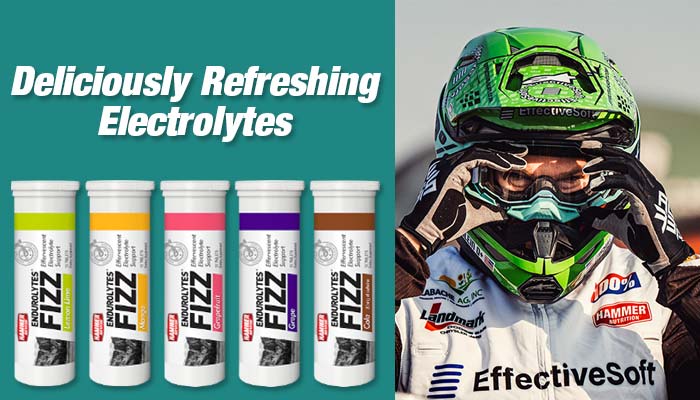It’s STILL the Superior Sports Drink, Bar None!
BY STEVE BORN
It’s hard to believe that a full 20 years ago, Brian informed those of us involved in any aspect of product development that it was time to make the best sports drink possible, to tangibly answer the ever-increasing cries: “Can anyone make a drink mix that’s not loaded with sugar and artificial ingredients, and doesn’t taste so syrupy sweet?”
It was an ambitious goal but one that we were very confident we could reach. After taste testing more formulation prototypes than we’d care to remember, we nailed it. I mean, NAILED IT. The flavor profile was exactly how we wanted: subtle and refreshing, and without the yucky “my mouth is coated in sugar” aftertaste. Plus:
- Plenty of calories per serving (110)
- A full-spectrum electrolyte profile (not just salt, which is found in excess amounts in other drink mixes)
- No tooth enamel-destroying citric acid
- Beneficial auxiliary nutrients such as chromium and l-carnosine (which most other sport drink manufacturers had most likely never even heard of)
- No artificial sweeteners (just a touch of healthy sweeteners, stevia and xylitol), as well as no artificial colors, flavors, or preservatives.
What’s not hard to believe is that in all that time, there’s not been a sports drink that comes close to HEED’s cleaner-than-clean ingredient list, as well as its second-to-none efficacy. This is because most-to-all of the other sports drinks continue to use all the other earlier-mentioned junk (e.g., refined sugar) that HEED has never contained. Even worse, many of the companies producing sports drinks have fallen prey to old and unapplicable research that suggests that jacking up the carb content to ridiculous levels—which means the baffling inclusion of fructose (see Fructose – The Worst of the Worst)—as well as increasing sodium content to outrageous levels (one product has an obscenely high 900mg of sodium per serving), somehow makes their product “state of the art.”
State of the art? That’s about as far from the truth as you can get.
And while HEED’s formula has remained mostly untouched, we have “ramped up our game” a bit on this already-superb drink mix. As Brian has always maintained, “My policy is simple: Any time I can improve a product, I will—and so I did.”
The main thing we did was to change from a corn-derived maltodextrin to a cassava root/tapioca-derived maltodextrin. This new complex carbohydrate source offers six performance-enhancing advantages, all of which are discussed in the Sidebar Column.
The second thing we did was to slightly increase the sodium content, not anywhere near an overly high amount (900mg per serving? Are you kidding me?), but to 150mg per serving, an amount that will serve athletes even better than before, especially when combined with HEED’s excellently balanced electrolytic mineral profile. Best of all, we didn’t just add more salt; that would have been the easy thing to do. Nope, we added a specific amount of sodium phosphate, a compound that has no peer when it comes to buffering excess acidity (which causes that burning sensation we all hate) while extending endurance by helping maintain optimal blood and muscle pH.
Summary
For nearly two decades HEED has been, and continues to be, the deliciously healthy and highly effective alternative to the syrupy swill disguised as sports drinks. Containing only beneficial ingredients, devoid of all the earlier-mentioned junk, and with two new beneficial features, HEED—now referred to as HEED 2.0—is exactly what you want and need. And with hot weather here, you’ll find that HEED will continue to go down nice and smooth. You’ll find HEED refreshing to drink, not frustrating!
SIDEBAR
The original HEED® formula used corn-derived maltodextrin (complex carbohydrate), which was an outstanding maltodextrin. However, while corn-derived maltodextrin was indeed excellent, tapioca-derived maltodextrin is even better. Whenever possible, “better” is what we strive for when it comes to Hammer Nutrition products!
SIX ADVANTAGES OF A TAPIOCA-DERIVED MALTODEXTRIN
- Tapioca requires far less processing than corn.
- Unlike corn, there is no GMO content in tapioca to begin with, so even though every single batch of the corn-derived maltodextrin we used in our products always tested at 0ppb (parts per billion) for GMOs, going with tapioca just saves us that hassle.
- Tapioca maltodextrin has lower amounts of sodium and higher amounts of naturally occurring potassium. Given that most everyone consumes far too much sodium as it is, having more potassium and less sodium is a definite plus.
- Tapioca maltodextrin has a more alkaline pH than corn-derived maltodextrin. Considering that we athletes are “acid-producing machines” during exercise, a more alkaline pH is a highly desirable feature/benefit.
- Tapioca maltodextrin has a lower Dextrose Equivalent (DE) than corn maltodextrin, which means fewer naturally occurring monosaccharide and disaccharide (short-chain sugar) content, and a much higher percentage of polysaccharide (complex carb) content—in essence, a more “complex” complex carbohydrate—for even longer-lasting energy and endurance.
- Tapioca maltodextrin has the same Glycemic Index (GI) as other forms of maltodextrin, so you get the fast-acting energy that you’re looking for.










10 comments
Long time Hammer fan here. Didn’t researchers last week at the Cleveland Clinic find an increased risk of stroke and heart related deaths due to xylitol? Your thoughts?
———
Hammer Nutrition replied:
Hi David. Thanks for your comment and, even more so, for being a valued client of Hammer Nutrition for many years. I have read and reread this latest research on xylitol and, like the earlier erythritol study—both of which were performed by the same researchers—I found so many “red flags” in it that I’m convinced that it’s one of the poorest studies I’ve reviewed in my 30+ years of studying these kinds of things. One of the main things to understand is that this is an observational study. Regarding observational studies, one site states that they “are a lower standard of evidence than experimental studies, are more prone to bias and confounding, and cannot be used to demonstrate causality.” Put another way, this study can show only an association/correlation between xylitol and heart risk… a very weak association at that (no matter what mainstream media’s overly sensationalistic headlines may say). It cannot and does not show that xylitol caused the higher incidence of heart attack, stroke, or death. Additionally, it is extremely important to note that the overwhelming majority of the participants were very unhealthy to begin with, and no history of their dietary practices prior to the study, or in the 3-year follow-up period, were addressed in the research. These and numerous other variables not taken into account in the study, are what make it completely unreliable for establishing xylitol as the cause for the cardiovascular issues mentioned in the study. I have written a lengthy and more-detailed reply to clients regarding this study and the issues in it. Please email me (Steve Born) at sborn@hammernutrition.com if you’d like me to send this to you.
This is a really good drink mix and my go to for under two hour rides!
———
Hammer Nutrition replied:
Hi Herman! Thanks for your positive feedback on HEED… I am in complete agreement with you!
Thank you for explaining what is in your products and showing the consumer. I have been using HEED for 5 seasons now. I have also recommended it to my fellow golfers.
———
Hammer Nutrition replied:
Hi Linda! You are most welcome for the information! We very much appreciate your longtime use of HEED and that you are recommending it to other golfers. Over the years, HEED really has become a hit in the golfing world!
I’ve been using heed for many years. It’s a most excellent product. Great taste, all flavors, I plan on using this product for many years to come.
———
Hammer Nutrition replied:
Hi Brian! Thank you so much for the positive feedback on HEED… we really appreciate it! Even more so, thank you for being a valued member of the Hammer Family for so many years, and you can bet that we will continue to produce only the finest products for you and all of our clients.
The one obvious change I have noticed switching from Heed to Heed 2.0 is that there has been a change in the way Heed 2.0 tastes compared to the old formulation. It has taken some time for me to get used to the change but I have. It remains my go to drink for my bike rides. The taste of Perpetuum 2.0 has also changed but not to the same degree as Heed 2.0.
———
Hammer Nutrition replied:
Hi John! There is a bit of a difference taste-wise between the corn-derived maltodextrin (Classic HEED) and the casava root/tapioca-derived maltodextrin (HEED 2.0). While we are unable to get an 100% exact replication of taste between the original Classic version and the newer 2.0 version, believe me, we tasted a LOT of samples to make sure that the taste was not just good, but excellent. I’m very pleased to hear that you’ve grown accustomed to the new taste and that you are enjoying the beneficial features of the casava root/tapioca-derived maltodextrin (see “Six Reasons Why Tapioca is Tops” at https://hammernutrition.com/blogs/endurance-news-weekly/six-reasons-why-tapioca-is-tops for more). The slight change in taste in Perpetuem 2.0 may be less noticeable than HEED 2.0 because the protein and fat components in Perpetuem also come into play, whereas HEED is a carbohydrate-only drink.